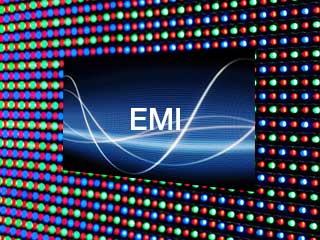LED Screen Electromagnetic Interference and FCC
Our magazine by-passed the topic of the electromagnetic interference (EMI) from LED screens since the experts believed that the large LED screen manufacturers found ways to eliminate the problem.
Modern LED Screens: Characteristics, Technologies, Reasons to Choose

It’s important to remember that at the time when first LED screens appeared nobody ever thought of measuring the levels of electromagnetic interference. However the concentration of electronic devices in one small space – be it LEDs; or power supplies; or controllers; or kilometers of wires – had to lead to some complications. The electromagnetic interference of LED screens started to increase and interfere with the normal operation of communication devices: including police radios, TV antennas and even the work of public city transport.
The first and obvious solution to shield the electromagnetic interference yielded positive results. However, this lead to considerable price hike and significant increase LED screen weight. But this was not the worst. By this time LED screens became fashionable and were frequently used as rental equipment for exhibitions, concerts, corporate events and official conventions. Clearly, rental equipment has to be sufficiently lightweight to be assembled and dismantled at regular intervals. But the main problem was that in all these events LED screens had to be located fairly close to the public turning into potential health hazard.
Much better solution was to utilize modern technological advances in manufacture of PCBs, selecting electronic components of better quality, monitoring of electromagnetic interference and shifting the peaks of electromagnetic radiation to the “safe” areas. The first to react to this new hazard were the government agencies of some European countries (primarily Germany), who set the admissible levels of electromagnetic interference as a legal requirement of doing business.
The USA followed suit and for the time it seemed that the situation drastically changed for the better. The European and American giants in LED screen production – such as Daktronics, Barco and others – followed the legal guidelines and other smaller manufacturers had to comply.
However it turned out that the problem had not disappeared. From time to time the facts about high electromagnetic interference from LED screens make the news. Most this concerns the LED screens imported from Korea, Taiwan and China. The quality of such LED screens has drastically improved, the prices are kept at bottom low, and the American and European businessmen started importing them in large numbers. Such imports hurt the small and medium-sized manufacturers that started looking for every opportunity to stop Asian imports from spreading in their countries.
For example, the US company Watchfire Signs (Illinois) petitioned the government agencies asking to prohibit using imported LED screens because the level of their electromagnetic interference negatively affects operation of other electronic devices: from portable smartphones to air traffic control towers.
The internal investigation proved that the levels of electromagnetic interference on Asian LED screens seriously exceed the admissible levels set by the FCC. The design architecture that is used by most manufacturers in Asia requires an intermediate controller unit called a “receiver card” which sits between the controller and the LED screen modules. It is a design that focuses on delivering a cheap product, and unfortunately it also delivers electromagnetic interference.
According to Watchfire Signs, the work of the electronic devices that do not meet the FCC electromagnetic interference standards may be terminated while all expenses related to dismantling the equipment, repairing and testing will be borne by the company-operator. The fact is that the USA customers are lured by significantly lower Asian prices and forget all about USA regulations. This sets them on the path of violating the law, potential financial losses and negative effect on health.
What's even more troubling is evidence that some importers are temporarily altering their LED screens with a “cheat mode” to pass testing, and then changing them back for shipping and installation. Such unscrupulous businesses should be blacklisted to prevent any long-lasting detrimental effect on entire LED screen industry.
Whatever the case, the problem with the electromagnetic interference remains mostly unresolved. The manufacturers are using cheap outdated and outmoded control systems without paying any attention or even understanding to the requirements for lower electromagnetic interference levels. At the same time there exist a number of technologically proven “pure” control systems. The American systems are excellent but expensive.
We have already written about Russian advanced technological developments that allow manufacturing modern “economy-class” control systems. For example, LED screen control systems by the Russian company “NAO-Pro” have adapted to the lowest possible electromagnetic interference levels that meet the most stringent requirements. We hope that sooner or later the problem with electromagnetic interference will be solved and LED screens will continue to be not only attractive advertising carriers but also completely safe to people and communication devices.





